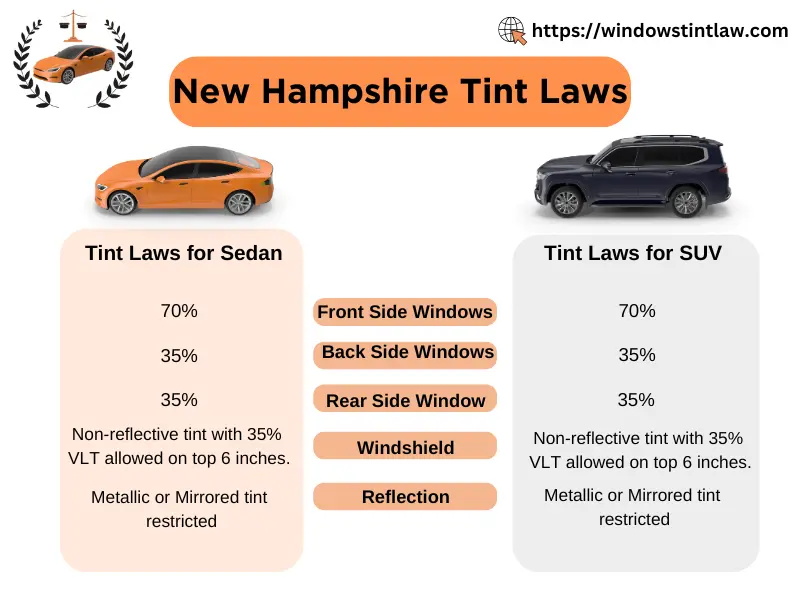New Hampshire tint laws were legislated in 1990 to lessen the risk of accidents due to illegal window tints.
Tinted windows have various advantages. On the other side, it may pose a risk to the safety of drivers and passengers. Window tinting rules of New Hampshire permits vehicle owner to tint front side windows which must allows Visible Light Transmission of more than 70 percent. However the back side windows and rear window must pass more than 35 percent of the visible light, when tinting material is applied.
Furthermore, Check out the below sections to find the details about New Hampshire window tinting rules.
Overview of New Hampshire Tint Laws
The below infographic outlines the legal tint limits for Cars and SUVs operated in New Hampshire. Motorists are advised to follow these limits to avoid tint tickets.

Darkest Legal Tint in New Hampshire
Darkest legal tint limits for Cars and SUV or Multi-purpose vehicles operated in New Hampshire are given in the below tables:
Tint Darkness For Sedan or Coupe
| State | Front Side Windows | Back Side Windows | Rear Window | Windshield | Tint Reflection | Other Restrictions |
| New Hampshire | 70% | 35% | 35% | Non-reflective tint with 35% VLT can be applied on top 6 inches of front windshield. | Metallic or Mirror-like appearance is prohibited. | None |
Tint Darkness For SUV or Vans
| State | Front Side Windows | Back Side Windows | Rear Window | Windshield | Tint Reflection | Other Restrictions |
| New Hampshire | 70% | 35% | 35% | Non-reflective tint with 35% VLT can be applied on top 6 inches of front windshield. | Metallic or Mirror-like appearance is prohibited. | None |
Window Tint Reflection
Motorists are not allowed to apply or affix tinting materials on the vehicle windows which produce metallic or mirror look. The shiny type of window tints are also prohibited in the state. This rule is applicable for Sedan and SUV type vehicles.
Moreover, the front side windows on the immediate left and right side of driver should be covered with non-metallic tint. Also, reflective tinting materials are restricted to install on Back side windows and rear window.
Other Rules and Regulations
Besides window tint darkness and reflection limits, there are some other rules to be followed in New Hampshire:
- Dual Side Mirrors: Dual side mirrors are mandatory if the rear window of the vehicle is tinted.
- Prohibited Tint Colors: No tint colors are specifically restricted in the state.
- Certificates: Window Film Manufacturers do not need to get certification of the tinting materials they sell in the state.
- Sticker: Sticker or label to identify the legal tinting is not required to display on automobile windows.
Medical Exemption
New Hampshire window tinting laws allow to install lower tint on vehicle windows due to certain medical issues. The commissioner may waive the requirements of RSA 266:58-a and provide a medical exemption certificate to a person who, for legitimate medical reasons, requires front windshield tinting. The medical waiver grants permission to apply tint on front windshield that must pass 70 percent or more light.
The tint waiver granted by the commissioner is valid for two years; however, if a licensed doctor or physician prescribes, the validity of the medical tint waiver may be extended for not more than four years.
Within 20 days of receiving application for tint waiver, The decision to grant or deny the medical tint waiver shall be concluded. Medical tint waiver can be obtained free of cost.
Penalties for Violating New Hampshire Tint Laws
Any person who violates window tinting laws of New Hampshire shall be guilty of non-moving traffic violation. The first offense shall cost $93 for illegal window tints, however the subsequent offense can add up hundreds of dollars. Moreover, Law enforcement agencies can stop and test the tinted windows with an electronic device , if they suspect illegal tints are applied.
Hence, drivers are advised to obey the window tinting rules of the state to avoid getting pulled over by the police.
